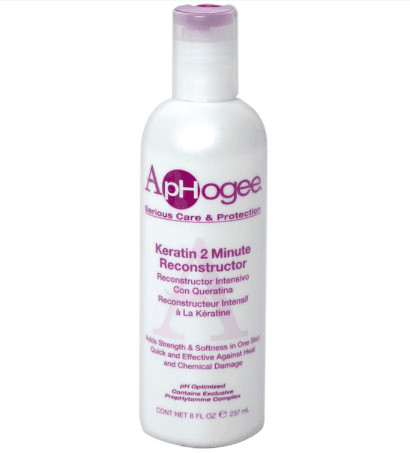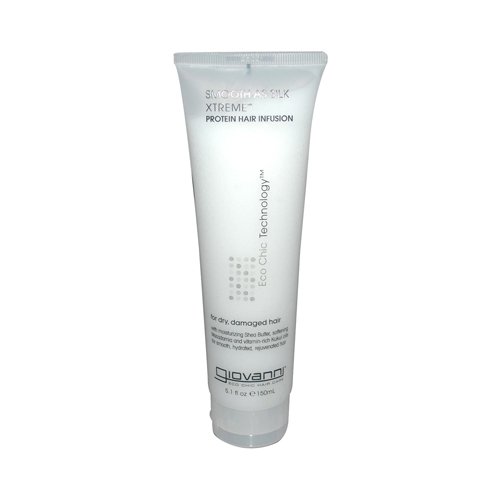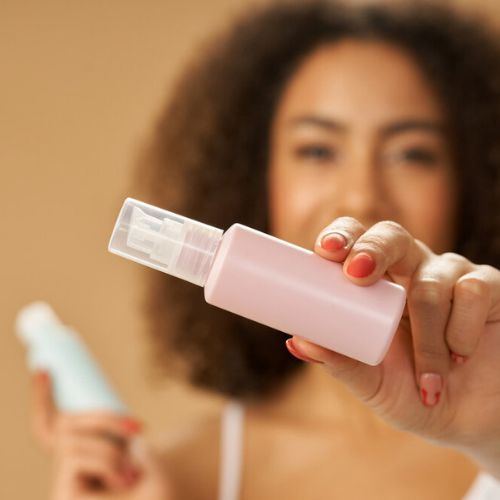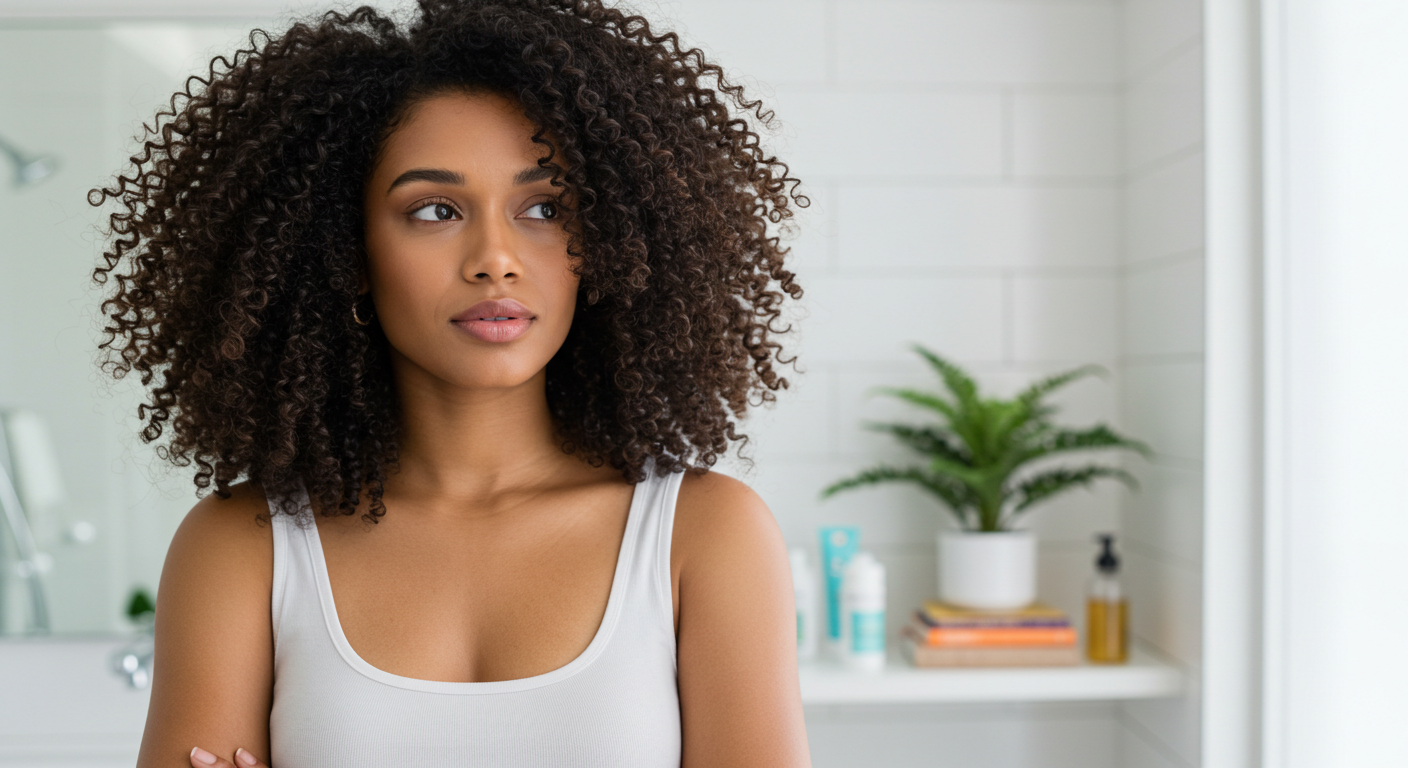The question I often get asked in my Instagram DMs is, “Does low-porosity hair need protein?” The short answer is, yes, low porosity hair can benefit from protein, and understanding the reasons behind this necessity requires an exploration of the distinctive attributes of low porosity hair, taking into account the overall health and condition of your hair.
In today’s blog, I’ve enlisted the expertise of my friend, a hair scientist with a PhD in Chemistry, to provide valuable insights into the science behind protein and its significance for individuals with low-porosity hair.
Why Low Porosity Hair May Need Protein
To optimize protein use for your hair, it’s crucial to consider your hair’s porosity. Similar to our skin, hair porosity is defined by microscopic pores on the hair surface, determining the absorption or desorption of materials. The compatibility of proteins with low-porosity hair often sparks confusion among individuals with different hair porosity types.
We typically associate high porosity hair needing protein, which, addresses the gaps in the cuticle layer prevalent in damaged strands. Various factors contribute to enlarged hair pores, increasing porosity and affecting the hair’s capacity to absorb and retain moisture.
Low porosity has smaller pores and a reduced absorption capacity, and it can increase its porosity when exposed to:
- Chemical treatments.
- Prolonged exposure to sunlight.
- Environmental stressors impacting hair health.
- Aging results in natural wear and tear.
- Mechanical stress from styling practices.
- Chlorine in pools.
Though there isn’t a standardized scale, assessing your hair’s current condition and its past treatments aids in categorizing it. This consideration becomes crucial in understanding and addressing the specific needs of your unique hair type for optimal care.
Understanding the Role of Protein in Hair Health

Our hair predominantly consists of the protein keratin, vital for strength and structure. This protein, found in the cortex (see illustration above), acts as the glue holding strands together. In addition to keratin, the other elements that compose the chemical composition of hair are: water, lipids, minerals, and pigments. Without protein, our hair strands would be brittle and weak.
Protein as a Building Block
Similar to muscles needing protein for growth, our hair relies on it as the building block for strength and elasticity. Protein enhances curl definition, helps prevent moisture loss, leading to healthy hair.
Proteins: Low vs. High Molecular Weight
Hair care products often feature plant-derived proteins, with their effectiveness influenced by molecular weight. Low molecular weight proteins penetrate deeply, while high molecular weight proteins form a coating, improving the hair’s surface.
Tip
For low-porosity hair, it’s beneficial to opt for products with a lower concentration of protein. Excessive protein application can be counterproductive and potentially cause more damage, so it’s essential to be mindful of the amount of protein you use.
Understanding the mechanisms of low and high molecular weight proteins is essential, as they produce different effects on hair quality. Here is a short list of high molecular and low molecular proteins:
High Molecular Weight Proteins:
- Hydrolyzed wheat protein PG-propyl methylsilanediol (synthetic)
- Laurdimonium hydroxypropyl hydrolyzed wheat protein (synthetic)
- Hydrolyzed wheat protein PG-Propyl silanetriol (synthetic)
- Hydrolyzed collagen (natural but high molecular weight)
- Stearyldimonium hydroxypropyl collagen (synthetic)
- Albumen (natural, large molecule size and weight)
Low Molecular Weight Proteins:
- Wheat amino acids
- Silk amino acids
- Silk protein
- Rice protein
All four above are naturally sourced.
For a detailed exploration of the best proteins tailored for low porosity hair, check out this in-depth post.
Optimizing Protein Treatment for Low Porosity Hair
For effective protein treatment on low porosity hair and to enhance your curl pattern, consider the following:
- Choose proteins that are lightweight to avoid protein overload.
- Pay close attention to your hair’s response to the protein treatment. If the reaction is negative, reduce or discontinue use immediately.
- Target damaged or weak parts of your hair by applying protein treatment specifically to the ends, which undergo significant wear and tear.
- Given that the ends are the oldest part of your hair, providing extra care to them is essential.
Recommended protein treatments for low-porosity hair include:
Protein Treatment / Deep Conditioner
Use protein-containing hair products, including a hair mask, once a week or every other week initially, adjusting frequency as your curly hair strengthens and requires less protein.
Protein Conditioners
By using the right products, you can incorporate protein treatments once or twice a week for low-porosity hair. Adjust the frequency as needed, making it a part of your wash day routine.
FAQs
Now, let’s explore some key questions related to protein treatments for low porosity hair.
Can low porosity hair use protein?
Low porosity hair requires protein but it needs to be used with caution. The key is to choose the right types of proteins with low to moderate dosage levels.
Those with low porosity hair should search for the following points:
• Nature-sourced proteins: Nature-derived proteins are recommended. The examples are “Hydrolyzed” proteins. They are water-soluble and thus are easy to rinse off and do not cause protein overload.
• Type of protein: High molecular size proteins are preferred for low porosity hairs. These molecules are large and therefore cannot pass through cuticle openings. They stay on the hair surface.
• Protein dosage: When perusing a product label, pay attention to the INCI listing on the product label. If protein is within the first four to five ingredients, this signifies that it’s highly concentrated and not ideal for low-porosity hair types.
When does low-porosity hair need protein?
Low-porosity hair can use protein treatments once a week (or as needed), especially after excessive brushing, combing, or heat styling. This will help restore your hair’s health and boost its quality.
Furthermore, if you frequently utilize a pool or often go to the beach, it is advised that you use protein products. It would address the chlorine-induced damage to hair proteins caused by chlorine and can restore the mechanical strength of hair fibers.
Is low porosity hair sensitive to proteins?
Low porosity hair is not inherently protein sensitive. Protein sensitivity arises when hair reacts unfavorably to too much protein-based products, resulting in manifestations like unruly frizz, stiffness, brittle hair, and even dry hair. While all hair types can benefit from proteins, the interaction depends on factors like source, molecular weight, and size.
Choosing the right protein, considering key ingredients, is crucial, as using the wrong type or excessive amounts, having coarse texture, maintaining the right balance between protein and moisture, mistimed use, and buildup can lead to issues like temporary brittleness or stiffness.
How do we fix a negative reaction to protein?
If your low-porosity hair feels dry and straw-like after protein application, follow these steps into your hair care routine:
- For best resuts, immediately wash your hair with a clarifying anti-residue shampoo.
- Use a regular moisturizing conditioner or leave-in conditioner to counteract the straw-like texture. It’s a good thing to provide additional moisture to your hair, especially if it has been a long time since your last treatment.
- Once dry, apply a light-textured hair oil to lubricate the hair shaft and reduce fiber-to-fiber friction.
- Stop the use of the protein product immediately.
References:
1. Hessefort, Y. Z.; Holland, B. T.; Cloud, R. W., True porosity measurement of hair: a new way to study hair damage mechanisms. J. Cosmet. Sci. 2008, 59 (4), 303.
2. Neudahl, G. A., Proteins for conditioning hair and skin. In Conditioning Agents for Hair and Skin, Schueller, R.; Romanowski, P., Eds. Taylor & Francis: 1999; pp 139-166.
3. Syed, A. N.; Ayoub, H., Correlating porosity and tensile strength of chemically modified hair. Cosmetics and toiletries 2002, 117 (11), 57-64.




















